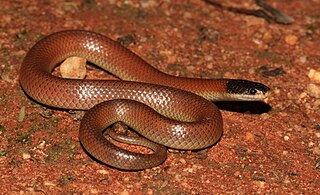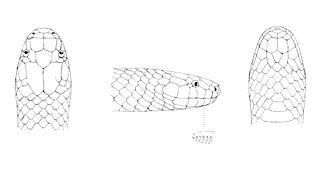
Acanthophis is a genus of elapid snakes. Commonly called death adders, they are native to Australia, New Guinea and nearby islands, and are among the most venomous snakes in the world. Despite their common name, they are not adders at all and belong to the Elapidae family. The name of the genus derives from the Ancient Greek akanthos/ἄκανθος ('spine') and ophis/ὄφις ('snake'), referring to the spine on the death adder's tail.

The inland taipan, also commonly known as the western taipan, the small-scaled snake or the fierce snake, is a species of extremely venomous snake in the family Elapidae. The species is endemic to semi-arid regions of central east Australia. Aboriginal Australians living in those regions named the snake dandarabilla. It was first described by Frederick McCoy in 1879 and then by William John Macleay in 1882, but for the next 90 years it was a mystery to the scientific community; no further specimens were found, and virtually nothing was added to the knowledge of this species until its rediscovery in 1972.

The eastern brown snake, often referred to as the common brown snake, is a species of highly venomous snake in the family Elapidae. The species is native to eastern and central Australia and southern New Guinea. It was first described by André Marie Constant Duméril, Gabriel Bibron, and Auguste Duméril in 1854. The adult eastern brown snake has a slender build and can grow to 2 m (7 ft) in length. The colour of its surface ranges from pale brown to black, while its underside is pale cream-yellow, often with orange or grey splotches. The eastern brown snake is found in most habitats except dense forests, often in farmland and on the outskirts of urban areas, as such places are populated by its main prey, the house mouse. The species is oviparous. The International Union for Conservation of Nature classifies the snake as a least-concern species, though its status in New Guinea is unclear.

Pseudonaja is a genus of highly venomous elapid snakes native to Australia. Species of this genus are known commonly as brown snakes and are considered to be some of the most dangerous snakes in the world; even young snakes are capable of delivering a fatal envenomation to a human.

Walterinnesia is a genus of venomous snakes in the family Elapidae. The genus contains two species, known commonly as desert black snakes or black desert cobras, which are endemic to the Middle East. The generic name Walterinnesia honours Walter Francis Innes Bey (1858–1937), who was a physician and zoologist in Egypt.

Pseudechis is a genus of venomous snakes in the family Elapidae. It contains the group of elapid species commonly referred to as the black snakes. Species of Pseudechis are found in every Australian state with the exception of Tasmania, and some species are found in Papua New Guinea. They inhabit a variety of habitat types, from arid areas to swampland. All species are dangerous and can inflict a potentially lethal bite. Most snakes in this genus reach about 2 m (6.6 ft) in total length, and vary in colour. Some species are brown, whereas others are black. The most recognisable and widespread species in the genus are the red-bellied black snake and the mulga snake. These snakes feed on lizards, frogs, birds, small mammals, and even other snakes. All species of Pseudechis lay eggs with the exception of the red-bellied black snake P. porphyriacus which is viviparous. The genus Pailsus is a synonym of Pseudechis, and more work is needed to understand species limits among the smaller species of the group.

The king brown snake is a species of highly venomous snake of the family Elapidae, native to northern, western, and Central Australia. Despite its common name, it is a member of the genus Pseudechis and only distantly related to true brown snakes. Its alternative common name is the mulga snake, although it lives in many habitats apart from mulga. First described by English zoologist John Edward Gray in 1842, it is a robust snake up to 3.3 m (11 ft) long. It is variable in appearance, with individuals from northern Australia having tan upper parts, while those from southern Australia are dark brown to blackish. Sometimes, it is seen in a reddish-green texture. The dorsal scales are two-toned, sometimes giving the snake a patterned appearance. Its underside is cream or white, often with orange splotches. The species is oviparous. The snake is considered to be a least-concern species according to the International Union for Conservation of Nature, though may have declined with the spread of the cane toad.

Polypedates colletti is a species of frog in the family Rhacophoridae. It is found in the Malay Peninsula, southern Vietnam, Borneo, Sumatra, and islands of the South China Sea.

Dwyer's snake also known as the whip snake and the variable black-naped snake, is a species of venomous snake in the family Elapidae. The species is endemic to Australia, where it is found from New South Wales to South Queensland. While closely related to Australian sea snakes, P. dwyeri is a terrestrial reptile.
The spotted mulga snake, also known commonly as Butler's black snake and Butler's snake, is a species of venomous snake in the family Elapidae. The species is endemic to Western Australia. It is a member of the genus Pseudechis, dangerously venomous snakes that can intimidate an opponent by raising the head and presenting a hood. This cobra-like threat display is supported by the ability to produce a very large amount of venom.

Goldie's tree cobra, also known as Gold's tree cobra, is a species of venomous tree cobra endemic to Central and Western Africa. This species is one of the two tree cobras in Africa, the other being the black tree cobra. Goldie's tree cobra is one of the most venomous snakes and creatures in Africa.
The blue-bellied black snake, also known commonly as the spotted black snake, is a species of venomous snake in the family Elapidae. The species is native to Australia.

The coastal taipan, or common taipan, is a species of highly venomous snake in the family Elapidae. Described by Wilhelm Peters in 1867, the species is native to the coastal regions of northern and eastern Australia and the island of New Guinea. The second-longest venomous snake in Australia, the coastal taipan averages around 2 m (6.6 ft) long, with the longest specimens reaching 2.9 m (9.5 ft) in length. It has light olive or reddish-brown upperparts, with paler underparts. The snake is considered to be a least-concern species according to the International Union for Conservation of Nature.
The Papuan black snake is a venomous snake of the family Elapidae native to New Guinea. Reaching around 2 m in length, it is a predominantly black snake coloured grey underneath.

Naja christyi, commonly known as the Congo water cobra or Christy's water cobra, is a species of venomous snakes belonging to the family Elapidae. The species is native to Sub-Saharan Africa. This species was formerly in the genus Boulengerina, but more recent research by Wallach et al. has shown that Boulengerina is actually a subgenus and Boulengerina christyi is a synonym of Naja christyi. This species has no known subspecies.
The Pilbara death adder, also known commonly as Wells' death adder, is a species of venomous snake in the family Elapidae. The species is one of the four members of the genus Acanthophis, a genus which is found throughout northwestern and southwestern Australia and some parts of southern Papua New Guinea. The species Acanthophis wellsi is endemic to Western Australia.
The eastern dwarf mulga snake, also known commonly as the eastern pygmy mulga snake and the false king brown snake, is a species of venomous snake in the family Elapidae. The species, which is native to Australia, was genetically confirmed as a distinct species in 2017.
The pygmy mulga snake, also commonly known as the pygmy king brown snake, is a species of venomous snake in the black snake genus Pseudechis in the family Elapidae. The species is native to Australia.
Ingram's brown snake is a species of venomous snake in the family Elapidae. The species is endemic to Australia.

Toxicocalamus loriae, also known commonly as the Loria forest snake, is a species of venomous snake in the family Elapidae. The species is endemic to New Guinea and occurs in both Western New Guinea (Indonesia) and Papua New Guinea.













